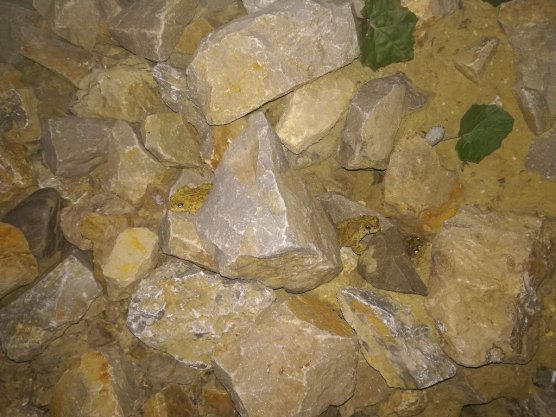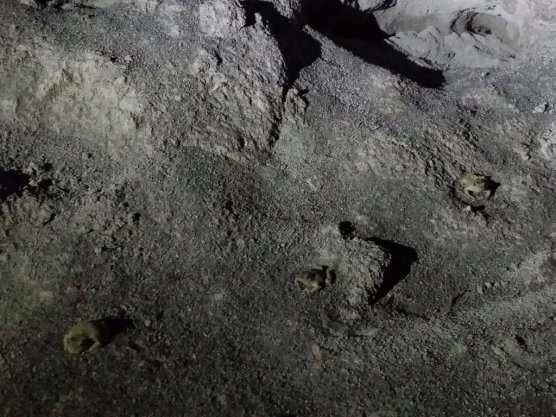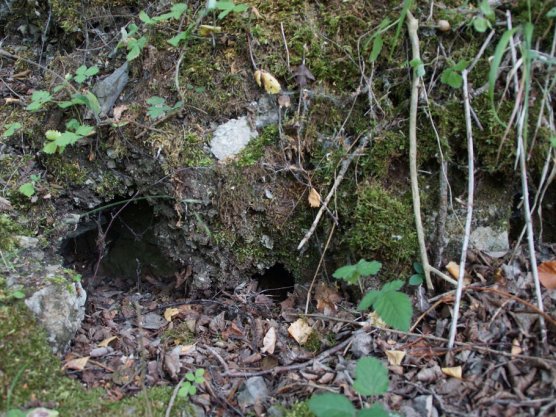
A conservation project for rare toads in the StädteRegion Aachen

Daytime hiding places, winter quarters and hunting grounds
Actions for the terrestrial habitat of frogs and toads
Due to their respective modes of life, adult yellow-bellied toads, common midwife toads and natterjack toads have different requirements for their terrestrial habitats. What all three species have in common is that they need open and sunny terrain with sparse vegetation as well as plenty of suitable hiding places in their “territory”.
In the Aachen CitiesRegion, the three amphibian species exist predominantly on military training areas and in quarries, gravel pits and on mine dumps, where the use or extraction activity has kept areas of the landscape open. Meanwhile, the period of use has been so long ago in some areas that plant repopulation – succession – has progressed in places to a stand of trees and shrubs.
Sunny terrain
The main task in the restoration and conservation of the terrestrial habitat is to remove woody vegetation, particularly from the sheltering places of the adult animals such as south-facing piles of log debris, gravel and sandy areas, as well as from the area surrounding the body of water used for spawning (see Photo documentation: Clearing woody vegetation). When the action has been completed, the terrestrial habitat is once again well exposed to sunlight and the cold-blooded, heat-loving target species find optimal living conditions. So that the terrain is kept free of woody vegetation for as long as possible, the roots are also removed, which can then be piled up elsewhere to serve as daytime hiding places. If the roots need to remain in the ground to stabilise a slope, they are either milled or cut crosswise so that they do not sprout again. To protect breeding birds, woody vegetation clearance takes place mainly between October and February.
Places for hiding and overwintering
Daytime hiding places and safe winter quarters are essential “home furnishings” for the natterjack toad, the common midwife toad and the yellow-bellied toad. To protect against desiccation, they search for cavities under or between stones, deadwood piles or the burrows of other animals. Natterjack toads and common midwife toads can burrow in loose soil, the natterjack toad down to a depth of around two metres.
If, in the vicinity of the breeding ponds, there are elements missing that would provide for suitable daytime hiding places or winter quarters, these are created – particularly in stepping stone biotopes – in accordance with good professional practice (e.g. NRW guidelines for amphibians "Wirksamkeit von Artenschutzmaßnahmen" – in German only). These include sandheaps, rockfill, drystone walls or deadwood piles.
To create winter quarters with frost-free hiding places, hollows about a metre deep are excavated and filled only with natural sand (sandheaps) or stones of various sizes piled on a bed of sand (rockfill). A drystone wall for common midwife toads was created, for instance, in the Stolberg district of Velau in the protected landscape area of Birkengang.
After clearing woody vegetation, the stumps can be used as a hiding place if they are stacked on the spot. Remains of old conveyor belt mats are also very popular as a daytime hiding place with natterjack toads, for example, and are specifically laid out for monitoring (link).
Habitats fit for the future
To maintain the structures and habitats established over the long term, areas are extensively cultivated where possible within the framework of the Kulturlandschaftsprogramm (cultivated landscape programme). That is, they are regularly mowed or grazed, and farmed without the use of fertilizers or pesticides. Arable land is also being extensified, since this type of habitat is used by the natterjack toad, particularly where subsidence creates temporary bodies of water in the fields. Not only the natterjack toad, but also other species living in the fields benefit from dispensing with the use of fertilizers and pesticides.
In quarries or on sandy or gravelly terrain, the topsoil – the area where nutrients for plant growth are found – is removed in places. This keeps plants from thriving. Plant cover is delayed, and maintenance is not needed as often.
 These natterjack toads have spent the day hiding in a pile of stones, emerging from their hiding place after dusk.© Claudia Korst
These natterjack toads have spent the day hiding in a pile of stones, emerging from their hiding place after dusk.© Claudia Korst
 Yellow-bellied toads like to spend their days in puddles and ponds. © Biologische Station StädteRegion Aachen e.V.
Yellow-bellied toads like to spend their days in puddles and ponds. © Biologische Station StädteRegion Aachen e.V.
 The midwife toads burrow into the sand heaps during the day and only appear in the evening © Biologische Station StädteRegion Aachen e.V.
The midwife toads burrow into the sand heaps during the day and only appear in the evening © Biologische Station StädteRegion Aachen e.V.



